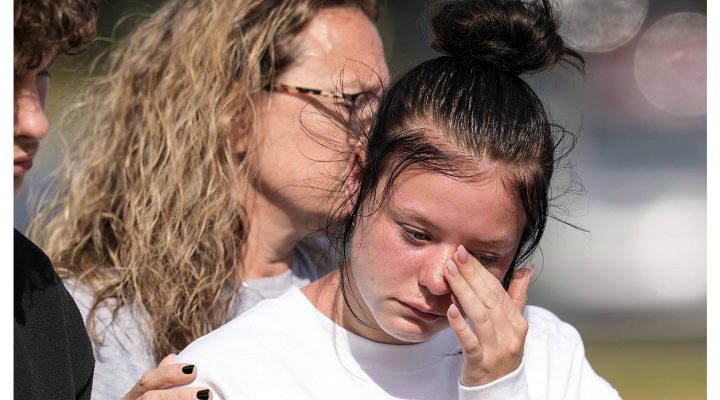For as long as I can remember, I have loved watching rivers, with their beautiful shapes, surfaces and movements. If you’ve ever watched a river, I’m sure you’ve noticed its current is a powerful thing. It shapes the river’s boundaries and creates its endlessly variable surfaces.
The current is what makes the river’s rapids flow and its whirlpools churn. It froths the river’s surf and calms the river’s flow. The current can move along peacefully, or it can whip and whirl brutally, violently stirring the waters within its banks, bringing it to a dangerous fever pitch around any rocks or rapids which stand in its way.
The beauty and vitality of a river is undeniable, but so too is its power. A river’s movements can be driven by an undercurrent of brutality. This undercurrent, at times, erupts in violence, especially if you happen to be someone trying to chart a course through its tumultuous rapids or slippery boundaries.

Andrea Johnson
As a lifelong Georgia resident, mother of two school-aged children and a disciple of Jesus Christ living in the aftermath of yet another school shooting this past week, I find myself wondering just how to chart my course through the undercurrent of brutality that feeds, fuels, whips, whirls and erupts into the never-ending river of gun violence that weaves a wide path, touching the majority of lives in America.
For as long as I can remember, I have reacted strongly to violence.
I feel a chill that runs from my head to my toes when I watch people experiencing violence.
My body aches when I read accounts of people’s experiences of violence. And I find I toss and turn at night when I have seen or heard violence that seems to run in, through and underneath the actions and interactions of people in our world — especially here in America concerning gun violence.
This past week, I experienced the latest instance of violence in our world: a school shooting that claimed the innocent lives of four precious victims here in my own state, only a few hours from my own home: students Christian Angulo, 14, and Mason Schermerhorn, 14, and teachers Richard Aspinwall, 39, and Cristina Irimie, 53.
As details emerged, reporting made clear this school shooter (like other American school shooters of the past) had a lived experience that included a troubled home life and cruelty from classmates and peers.
“As I reflected on this latest violent school shooting, I felt chills, I had aches and I tossed and turned almost every night.”
Reporting also made clear this school shooter had faced scrutiny from law enforcement for previous threats concerning gun violence. But with lack of evidence, and no “extreme risk/red flag law” in Georgia to even make possible the removal of deadly weapons from this shooter’s home, no arrest and no consequences could ensue.
Reporting also has clarified that this shooter experienced mental health struggles, and while some of his family members made efforts to get him the help he needed, the tragic happenings of this past week were not able to be prevented.
As I reflected on this latest violent school shooting, I felt chills, I had aches and I tossed and turned almost every night.
For as long as I can remember, two Gospel texts come to my mind when I reflect upon violence: Jesus’ arrest, in Luke 22:47-53, and the contextual framing of his arrest in Luke 22:35-38.
Here in these two texts, in the last miracle of Jesus’ earthly life, there is an opportunity to warm the chill in our bones, to heal our aching souls, to rest in the hope that violence — even and especially gun violence — will not have the last word over God’s hope of peace for creation.
Luke 22:35-38 is located within heavy eschatological foreshadowing. It’s placed in Luke’s narrative following the presentation of the Lord’s Supper and the disciples’ dispute with Jesus concerning greatness, as well as Jesus’ warning to Peter of his certain and imminent betrayal. The last pieces of Jesus’ identity are being put together here in Luke’s narrative and in it, we see a Jesus who is trying desperately to prepare those who follow him for their life without him.
Here in this passage, Jesus Christ is trying to teach the disciples about what it means to be his followers in the world — a world that will drastically change once he is dead and ascended into heaven. Before, when Jesus sent these people out, spreading the good news, these disciples needed nothing, as they acknowledge in verse 35. But now, with his impending death, Jesus knows he will not be “here” with his people. He knows they will be following him while living in a world set in a dangerous context of the Roman Empire. Jesus tells them that without him, only a purse, a bag and a sword — or two — will be enough.
Luke 22:47-53 details Jesus’ arrest. This passage is the lynchpin that unleashes the full violence of Christ’s crucifixion and death. Jesus’ arrest scene is replete with violence: The disciples’ sleepy indifference and lack of compassion; Judas’ cruel kiss of betrayal; and Christ’s own followers’ dismemberment of an enslaved person.
“In this text even Jesus’ own presence is not enough to stem the tide of violence.”
Here in this text is another sword, violently presented, and here again, this sword is gripped in Christ’s own disciple’s hand. The difference is that in this text even Jesus’ own presence is not enough to stem the tide of violence.
Under this second text’s surface, the undercurrent of brutality starts to pump. Can you feel it?
Anxiety and uncertainty rip through the disciple’s body. It whips and whirls violently as it senses the threat of Judas, the crowd and the temple police. It bumps up violently against the rock of their very faith, their own Savior, Jesus Christ, and transforms the peaceful footing of a night spent in prayer to the dangerous and murky waters where the forces of violence gather their power.
In the gleam of a blade, all gathered near are pulled underneath an uncertain surface, as they all slip down the brutal banks now slick with violence, and with the body and blood of an enslaved and innocent person.
Chills, aches and pain steal all peace as the undercurrent of brutality takes control in Luke 22:51. But Jesus Christ brings a word of peace in verse 52.
He steps forward, into the violent and painful flow of violence, and transforms its power. “No more of this!” Jesus says.
And with two hands full of peace and healing, he warms the wounded person’s chill and shock. He comforts his immense wound and pain. And he heals the destruction caused by his own disciple’s violence.
“Christ’s last earthly miracle was dedicated to healing the pain his disciples had wrought in the world.”
Christ’s last earthly miracle was dedicated to healing the pain his disciples had wrought in the world.
As Luke’s Gospel communicates to us, Jesus Christ’s way of discipleship cries out, “No more of this!” amid the violent ways of our world, especially the undercurrent of brutality that empowers gun violence in America.
Can you hear it? As a disciple of Jesus Christ, I can hear it. And because I can, I believe I must respond.
If we are to be Christ’s disciples in our violent world, we must fill our hands and our lives and our voices with the ways of Christ’s peace and healing.
We must cry out, “No more of this!” when we see the people around us being abused and mistreated by the cruel words spoken by those who swim amidst the whip and the whirl of the undercurrent of brutality.
We must speak out, “No more of this!” when we see people struggling with mental health and indoctrination before they slip away and are lost entirely to the undercurrent of brutality.
We must live out, “No more of this!” by supporting policies and people who reject the violent undercurrent of brutality and instead represent and promote the health and peace of gun-sense legislation in our country.
And most of all, we must speak Christ’s powerful words to ourselves, “No more of this!” in all times, places and situations in every part of our lives where we feel ourselves being pulled into the powerful undercurrent of brutality and its violent realities, most especially those where gun violence is concerned.
We must say it, again and again, and again: “No more of this!”
For as long as I can remember, gun violence has been the surface reflection of the undercurrent of brutality that whips and whirls powerfully beneath the violent culture in which we live. A powerful tide of hatred belies the hateful, cruel, marginalizing (and often) misogynistic, transphobic, homophobic, xenophobic and racist ideologies that power almost every instance of gun violence in our American society.
But as Luke 22:35-38 and 22:47-53 reveal, Christ’s ways of discipleship reflect the surface of God’s peace and the Holy Spirit’s hope for our world.
We can speak out against gun violence. We can support people and policies for gun-sense legislation. We can testify with our life’s actions to the transformative power of Jesus Christ!
And we can cry out in love and proclaim: “No more of this!”


